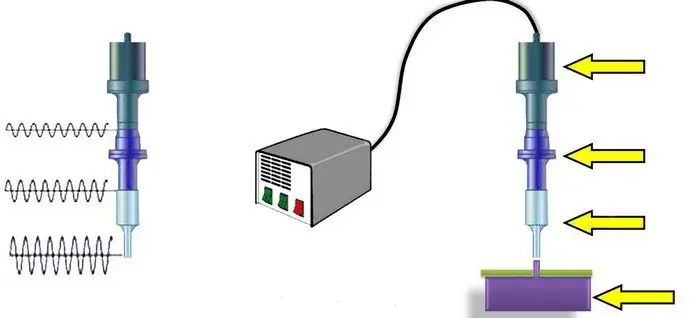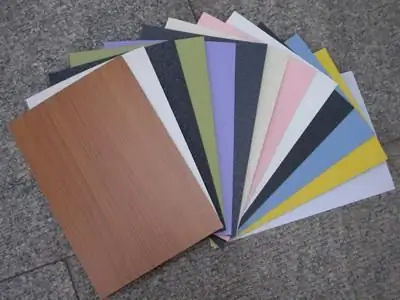2025 Author: Howard Calhoun | [email protected]. Last modified: 2025-01-24 13:10:31
Special composite materials are used in the insulation systems of complex devices and structures that are subject to increased operational requirements. As a rule, these are not universal, but highly specialized products, oriented to work in extreme thermal and humidity conditions. Such insulators include the following laminates: getinax, textolite, fiberglass, as well as their modifications. Due to the combination of strength and thermal insulation qualities, such composites can be used in structures, devices and devices that are responsible for their intended purpose.
Laminated applications

The range of applications for such polymers is very diverse. This includes machine tool building, aviation technology, manufacturing industries, as well as construction and the chemical industry. Wherever the use of electrical insulation is required, materials are usedof such kind. At the same time, one cannot speak of their universality. There is a wide range of modifications in which laminates are presented. The application of each version of the composition focuses on a specific area. For example, getinaks is suitable for the manufacture of inexpensive components in electrical appliances, and wood-laminated materials are used in technical mechanisms due to their rigid structure. The field of application of textolite is quite extensive, which covers both the electrical industry and petrochemical complexes, as well as small instrumentation.
What are laminates made from?

Laminated plastic is a composite material based on a polymer binder. To strengthen the functional base, layer-by-layer reinforcing filling is also used. In other words, laminates are a combination of two main components represented by a binder and a filler. Synthetic resins are used as the first ingredient. It can be polyester, epoxy, phenol-formaldehyde and other substances. The use of polymers is also widespread, among which are organosilicon and fluoroplastic materials. As for filling, this task can be performed by traditional raw materials in the form of asbestos and cellulose paper fibers.
Laminated plastic characteristics
In the classic version, laminate is a sheet material that is laid like conventional cladding panels. less oftentissue varieties are found. The thickness of the sheets can range from 0.4 to 50 mm, depending on the type and composition of the insulator. There are also different sizes in length and width. A standard fiberglass panel, for example, has an average size of 1200x1000 mm. The working qualities possessed by laminated plastics are expressed by the ability to withstand different temperature conditions. Again, the average corridor for a typical plastic of this kind varies from -60°C to 120°C. Subject to the inclusion of additional modifiers, this range may expand.

Fiberglass properties
The performance of this plastic is determined by its composition, which includes several layers of fiberglass, glued together using hot pressing technology. The binder in this case is a thermosetting epoxyphenol component. The basic properties endowed with laminates of this type include high heat resistance, protection from the negative effects of humidity and mechanical strength. In addition, unlike many composites, fiberglass is an environmentally friendly material, which expands its scope. Also, its high dielectric properties and durability contribute to its attractiveness in the market.
Getinax properties
Another common variation of laminate used as an electrical insulator. The working properties of this composite are determined by the paper base, processeda mixture of phenolic or epoxy resins.
This plastic lacks the combination of mechanical strength and ability to withstand extreme temperatures. Nevertheless, the pliable substrate allows the formation of printed circuit boards of any size. In addition, these are the cheapest layered plastics, which led to their wide use in instrumentation. Such material, in particular, produces stamped components for the technical support of low-voltage household equipment.

Textolite properties
The material is formed from cotton fabrics by hot pressing with the addition of thermosetting binders of the phenol-formaldehyde group. It was the use of a fabric base that provided the textolite with high compressive strength, as well as impact strength. The basis easily gives in to processing by drilling, cutting and stamping. This quality of the material has led to its use in the production of technological elements that are under the influence of electrical and mechanical loads.
At the same time, there are several categories into which commodity laminates are divided. The properties of the first category are expressed in the form of increased electrical insulation, which allows the material to be used both in air and in transformer oil. The second category is distinguished by increased mechanical properties, therefore, parts that are subjected to physical loads are more often made from plastic of this group. There are also special modifications.textolite, designed for use at elevated temperatures.

Wood Laminate Properties
The main structural difference of this type of insulating materials is the use of a wood base as a filler. In particular, the composite is supplemented with sheets of peeled veneer with a thickness of about 0.3-0.6 mm. Natural material binds to polymers by means of resole synthetic resins. As a result, the combined material acquires improved anti-friction properties, resistance to aggressive environments and even abrasives that other laminates cannot withstand.
Properties, application and operational requirements in this case are determined by a combination of a whole range of characteristics. The working qualities of the material are expressed not only by physical security, but also by moisture resistance, dielectric qualities, as well as maintaining stability at ultra-low temperatures at the level of -250 °C. In terms of use, wood-laminated materials are successfully integrated into the mechanisms of friction units, plain bearings, hydraulic gates and other technical systems.

Conclusion
Modern composites were originally developed with the aim of obtaining high-strength materials that could replace some metal alloys. As a result, the construction industry was able to find an alternative to traditional reinforcement in the form of fiberglass rods. In turn, laminated plastics have becomea good replacement for traditional insulators. They are not used where it is customary to lay mineral wool or cork panels, but specialized niches that lack the characteristics of conventional products of this type are actively developing new layered polymers. However, the future entry of such insulators into the domestic use segment is not excluded. In any case, the environmental friendliness of fiberglass can contribute to this.
Recommended:
Combustible gases: names, properties and applications

Combustible gases - hydrocarbons formed in the earth's crust as a result of thermal decomposition of organic residues. They are highly economical energy fuels
Polyols are polyhydric alcohols (polyalcohols): properties, production and applications

Polyols - safe or not? What are polyalcohols, why are they included in the composition of chocolate, chewing gum, foam rubber and antifreeze. The most famous polyols are sweeteners. Production of polyhydric alcohols in Russia and abroad
Types of plastics and their applications. Types of plastic porosity

Different types of plastics provide ample opportunities for creating certain designs and parts. It is no coincidence that such elements are used in a variety of fields: from mechanical engineering and radio engineering to medicine and agriculture. Pipes, machine parts, insulation materials, appliance cases and household products are just a few of the things that can be created from plastic
Zeolite - what is it? Zeolite natural and synthetic. Zeolite: properties, applications, benefits and harms

Its name translates as "boiling stone". It is impossible to count the uses of this seemingly simple mineral. It can even be eaten and used as a sieve for molecules. Such a versatile and useful zeolite
Welding of ultrasonic plastics, plastics, metals, polymeric materials, aluminum profiles. Ultrasonic welding: technology, harmful factors

Ultrasonic welding of metals is a process during which a permanent joint is obtained in the solid phase. The formation of juvenile areas (in which bonds are formed) and the contact between them occur under the influence of a special tool

